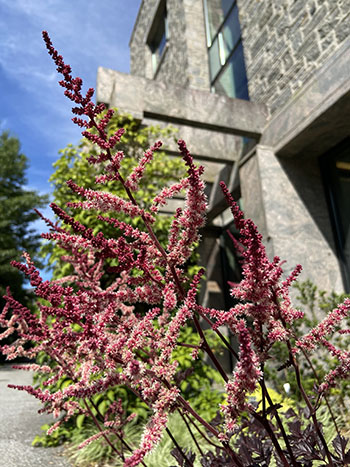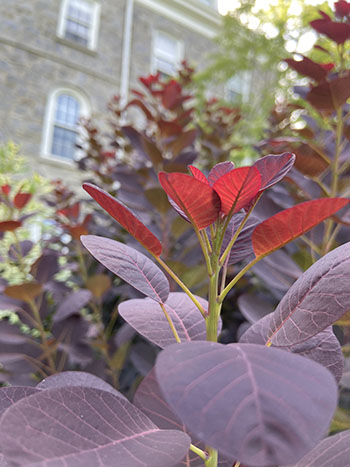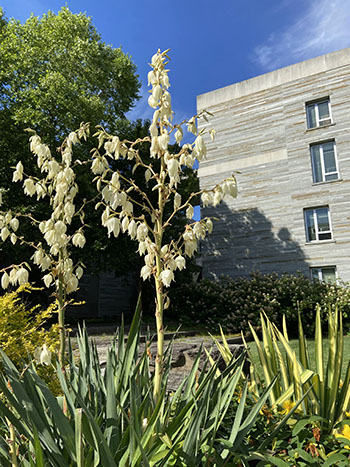
Plants of the Week: June 29
Guest Author: Public Horticulture Intern Megan Rossman
As my eyes move across a gardenscape, I like to consider the plants that give me pause. Not only for their beauty, but for the memories and associations they evoke. My selections for Plant of the Week are specimens that have allowed me to pause and set aside time for appreciation and thought in the Scott Arboretum.

Astilbe ‘Chocolate Shogun’
The Astilbe ‘Chocolate Shogun’ located in the North Kohlberg Hall border garden is a striking plant that gives me great anticipation. As Allen Lacy stated in his Practical Gardener article in the New York Times, “viewed up close, Astilbes are exciting things…they do not simply come into bud and bloom; rather they develop over a long period of time, in a process of unfolding.” The Astilbe ‘Chocolate Shogun’ is currently in this process. Slowly, from the bottom of the plume upwards, the pale pinkish-white flowers emerge from their dark purple buds creating a wonderful ombre. These flowers are set on handsome dark red stems above purple-brown serrated foliage.
This Astilbe is a striking plant indeed, and is a joy to watch it transform into bloom. It is a multidimensional, versatile, and adaptable plant. This herbaceous perennial is hardy in Zones 4-8 and can tolerate all sun levels, including full sun, as long as there is enough moisture to stop it from drying out. Its blooms are at their fullest in mid- to late-summer, is deer and rabbit resistant, and is loved by butterflies. I recommend visiting the Astilbe ‘Chocolate Shogun’ multiple times throughout the summer to fully take in its transformation and slow process of unfolding.
Photo credit: M. Rossman

Cotinus coggygria ‘Royal Purple’
On my walk to and from the Scott Arboretum every day, I pass by the Cotinus coggygria ‘Royal Purple’ (common smoketree). This deciduous shrub, in the Rose Garden Circle initially gave me pause due to its rich foliage. In the spring to early summer its ovate leaves are a deep maroon on the front and a bluish-green on the back, giving it incredible movement and texture in the wind. These leaves will gradually mature into a dark purplish-red to purplish-black later in the summer. This Cotinus coggygria prefers full sun, medium moisture, and well-draining soils. It is a solidly performing woody plant that will mature over time to 10-15 feet tall and wide and grows in Zones 4-8. I believe this shrub has a great amount of “curb appeal,” especially when planted with contrasts of color in mind, as done here in the Scott Arboretum. The matte maroon leaves of the Cotinus coggygria ‘Royal Purple” set against the variegated green leaves of the Cornus alba ‘argenteo-marginata’ create a noteworthy shrub border and a space I so enjoy wandering by every day.
Photo credit: M. Rossman

Yucca ‘Garland’s Gold’
Growing up not far from the desert southwest I am embarrassed to say that I have yet to see a yucca in bloom. Always too hot to travel to western Colorado during the late spring and early summer, I would miss out on the flowering desert dweller, only met with the towering dry stem when I would visit in the fall. You can imagine my surprise when exploring Gold Medal Garden I found the Yucca ‘Garland’s Gold’ (Variegated Adam’s Needle) in full bloom and specter.
This plant forms large rosettes of leathery sword-shaped leaves, the innermost leaves with a yellow center and green edges, the outermost leaves a more solid evergreen. When mature, these rosettes produce a tall spike loaded with large, creamy white flowers. Unless you’re going for a wilder-desert look, I would recommend trimming the flower spike down to the base, otherwise it will dry out and stay through the winter. This moth-pollinated yucca grows in full sun and dry conditions, making it great for difficult, exposed areas in the garden. I highly suggest visiting the Gold Medal Garden to see these beautiful blooms from this southwest US native.
Photo credit: M. Rossman





No Comments